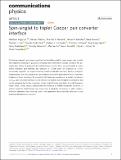Files in this item
Spin-singlet to triplet Cooper pair converter interface
Item metadata
| dc.contributor.author | Rogers, Matthew | |
| dc.contributor.author | Walton, Alistair | |
| dc.contributor.author | Flokstra, Machiel G. | |
| dc.contributor.author | Al Ma’Mari, Fatma | |
| dc.contributor.author | Stewart, Rhea | |
| dc.contributor.author | Lee, Stephen L. | |
| dc.contributor.author | Prokscha, Thomas | |
| dc.contributor.author | Caruana, Andrew J. | |
| dc.contributor.author | Kinane, Christian J. | |
| dc.contributor.author | Langridge, Sean | |
| dc.contributor.author | Bradshaw, Harry | |
| dc.contributor.author | Moorsom, Timothy | |
| dc.contributor.author | Ali, Mannan | |
| dc.contributor.author | Burnell, Gavin | |
| dc.contributor.author | Hickey, Bryan J. | |
| dc.contributor.author | Cespedes, Oscar | |
| dc.date.accessioned | 2021-04-09T14:30:31Z | |
| dc.date.available | 2021-04-09T14:30:31Z | |
| dc.date.issued | 2021-04-08 | |
| dc.identifier | 273733057 | |
| dc.identifier | d89bdedf-37a7-41d6-9f33-a0c0c590f8b2 | |
| dc.identifier | 85104057685 | |
| dc.identifier | 000638138900001 | |
| dc.identifier.citation | Rogers , M , Walton , A , Flokstra , M G , Al Ma’Mari , F , Stewart , R , Lee , S L , Prokscha , T , Caruana , A J , Kinane , C J , Langridge , S , Bradshaw , H , Moorsom , T , Ali , M , Burnell , G , Hickey , B J & Cespedes , O 2021 , ' Spin-singlet to triplet Cooper pair converter interface ' , Communications Physics , vol. 4 , 69 . https://doi.org/10.1038/s42005-021-00567-7 | en |
| dc.identifier.issn | 2399-3650 | |
| dc.identifier.other | Jisc: 5d4790c750cf42c395d9b09ebdfb1f6a | |
| dc.identifier.other | publisher-id: s42005-021-00567-7 | |
| dc.identifier.other | manuscript: 567 | |
| dc.identifier.other | ORCID: /0000-0002-2020-3310/work/92019819 | |
| dc.identifier.other | ORCID: /0000-0002-4333-1358/work/92020010 | |
| dc.identifier.uri | https://hdl.handle.net/10023/23003 | |
| dc.description | This work was supported by EPSRC grant nos. EP/S030263/1, EP/M000923/1 and EP/K00512X/1. Experiments performed at the ISIS Pulsed Neutron and Muon Source were supported by a beamtime allocation from the Science and Technology Facilities Council experiment number RB 1820617. PSI LEM beamtime access via proposal IDs 20161840, 20171184 and 20190352. | en |
| dc.description.abstract | Combining magnetic and superconducting functionalities enables lower energy spin transfer and magnetic switching in quantum computing and information storage, owing to the dissipationless nature of quasi-particle mediated supercurrents. Here, we put forward a system where emergent spin-ordering and diffusion of Cooper pairs are achieved at a non-intrinsically magnetic nor superconducting metallo-molecular interface. Electron transport, magnetometry and low-energy muon spin rotation are used to probe time-reversal symmetry breaking in these structures. By comparing the Meissner expulsion in a system including a Cu/C60 spin-converter interface to one without, we observe a paramagnetic contribution that can be explained due to the conversion of spin-singlet Cooper pair states into odd-frequency triplet states. These results demonstrate the potential of metallo-molecular interfaces to achieve singlet to triplet Cooper pair conversion, a capability not present in either metal or molecule separately that could be used in the generation and controlled diffusion of spin polarised dissipationless currents. | |
| dc.format.extent | 9 | |
| dc.format.extent | 2824244 | |
| dc.language.iso | eng | |
| dc.relation.ispartof | Communications Physics | en |
| dc.subject | QC Physics | en |
| dc.subject | TK Electrical engineering. Electronics Nuclear engineering | en |
| dc.subject | DAS | en |
| dc.subject.lcc | QC | en |
| dc.subject.lcc | TK | en |
| dc.title | Spin-singlet to triplet Cooper pair converter interface | en |
| dc.type | Journal article | en |
| dc.contributor.institution | University of St Andrews. School of Physics and Astronomy | en |
| dc.contributor.institution | University of St Andrews. Centre for Designer Quantum Materials | en |
| dc.contributor.institution | University of St Andrews. Condensed Matter Physics | en |
| dc.identifier.doi | 10.1038/s42005-021-00567-7 | |
| dc.description.status | Peer reviewed | en |
This item appears in the following Collection(s)
Items in the St Andrews Research Repository are protected by copyright, with all rights reserved, unless otherwise indicated.

